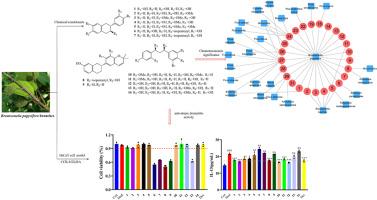纸莎草分枝的化学成分及其化学分类意义
IF 2
4区 生物学
Q4 BIOCHEMISTRY & MOLECULAR BIOLOGY
引用次数: 0
摘要
通过对桑科纸蓟花(Broussonetia papyrifera)分支的植物化学研究,分离出31个化合物,包括:9个黄烷(1-9)、5个二芳基丙素(10-14)、3个甾体(15-17)、2个蒽醌(18,19)、2个羟基苯甲酸(20,21)、3个萜类(22,25,27)、6个苯丙素(23,24,26,29 - 31)和1个杂环化合物(28)。其中化合物1、9、10、13、14、23和31为首次从桑科植物中分离得到。黄酮类化合物和二芳基丙烷类化合物(1-14)对抗特应性皮炎(AD)活性的评价表明,8种化合物抑制HaCaT细胞IL-13的分泌。值得注意的是,化合物2、10和12显示出最有效的活性,使IL-13的分泌低于阳性对照地塞米松的水平。此外,还详细讨论了分离成分的化学分类意义。本文章由计算机程序翻译,如有差异,请以英文原文为准。

Chemical constituents from the branches of Broussonetia papyrifera and their chemotaxonomic significance
Phytochemical investigation of the branches of Broussonetia papyrifera (Moraceae) resulted in the isolation of thirty-one compounds, including: nine flavans (1–9), five diarylpropanoids (10–14), three steroids (15–17), two anthraquinones (18, 19), two hydroxybenzoic acids (20, 21), three terpenoids (22, 25, 27), six phenylpropanoids (23, 24, 26, 29–31), and one heterocyclic compound (28). Among them, seven compounds (1, 9, 10, 13, 14, 23, and 31) were isolated from the Moraceae family for the first time. Evaluation of the flavan and diarylpropanoid compounds (1–14) for anti-atopic dermatitis (AD) activity demonstrated that eight compounds inhibited IL-13 secretion in HaCaT cells. Notably, compounds 2, 10, and 12 displayed the most potent activity, reducing IL-13 secretion below levels achieved by the positive control dexamethasone. Furthermore, the chemotaxonomic significance of the isolated constituents is discussed in detail.
求助全文
通过发布文献求助,成功后即可免费获取论文全文。
去求助
来源期刊

Biochemical Systematics and Ecology
生物-进化生物学
CiteScore
3.00
自引率
12.50%
发文量
147
审稿时长
43 days
期刊介绍:
Biochemical Systematics and Ecology is devoted to the publication of original papers and reviews, both submitted and invited, in two subject areas: I) the application of biochemistry to problems relating to systematic biology of organisms (biochemical systematics); II) the role of biochemistry in interactions between organisms or between an organism and its environment (biochemical ecology).
In the Biochemical Systematics subject area, comparative studies of the distribution of (secondary) metabolites within a wider taxon (e.g. genus or family) are welcome. Comparative studies, encompassing multiple accessions of each of the taxa within their distribution are particularly encouraged. Welcome are also studies combining classical chemosystematic studies (such as comparative HPLC-MS or GC-MS investigations) with (macro-) molecular phylogenetic studies. Studies that involve the comparative use of compounds to help differentiate among species such as adulterants or substitutes that illustrate the applied use of chemosystematics are welcome. In contrast, studies solely employing macromolecular phylogenetic techniques (gene sequences, RAPD studies etc.) will be considered out of scope. Discouraged are manuscripts that report known or new compounds from a single source taxon without addressing a systematic hypothesis. Also considered out of scope are studies using outdated and hard to reproduce macromolecular techniques such as RAPDs in combination with standard chemosystematic techniques such as GC-FID and GC-MS.
 求助内容:
求助内容: 应助结果提醒方式:
应助结果提醒方式:


